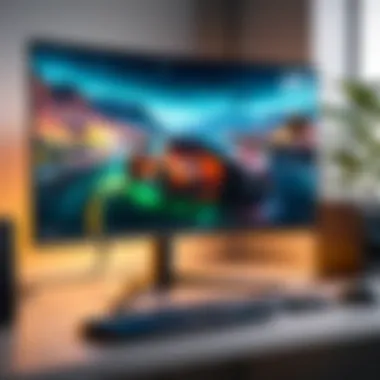The Best Low Price Computer Monitors for Every Need


Intro
In the current era of modern computing, having a suitable monitor is essential for enhancing productivity and providing an enjoyable viewing experience. The market boasts a plethora of low-priced computer monitors that promise quality without breaking the bank. This guide aims to navigate through these options, highlighting various aspects such as features, specifications, and performance, assisting users in making well-informed choices. Whether one is a gamer seeking quick response times or a professional requiring accurate color reproduction, there exists a monitor tailored to those needs without demanding a high financial outlay.
Through in-depth analysis of budget monitors, this guide will discuss competitive pricing, evaluate consumer preferences, and showcase the relevance of technological advancements. The diverse needs of users, from casual web surfing to graphic design, will be addressed, ensuring a comprehensive understanding of cheap and capable displays.
Product Overview
Selecting the right budget monitor involves considering its key features, brand reputation, and financial implications. Below details the important facets regarding various monitors that stand out in terms of value and utility.
Brand Information
Brands play an influential role in defining the reliability and quality of computer monitors. Some renowned names frequently appearing in the budget segment include Samsung, LG, Acer, and Dell. These brands have effectively integrated affordable technology with acceptable standards, ensuring users do not compromise quality for price.
Key Specifications
When evaluating low-priced monitors, notable specifications include resolution, refresh rate, and screen size. Popular choices typically feature:
- Resolution: Options range from Full HD (1920x1080) to 4K displays (3840x2160), providing clear visuals for various tasks.
- Refresh Rate: Monitors often vary between 60Hz to 144Hz, affecting smoothness in fast-paced applications such as gaming.
- Screen Size: Variety allows users to select between standard sizes from 21 inches to those exceeding 32 inches, accommodating different space requirements.
Pricing
Budget monitors generally sit within the price range of $100 to $300, depending on the specifications and the brand. It is imperative to monitor sales and discounts to maximize value. Searching for consistent deals at respected electronic retailers can further enhance the investment.
“Investing in a budget monitor does not mean settling for inferior performance.”
Performance Comparison
To make a fair evaluation of low-priced monitors, performance must be scrutinized through rigorous benchmarks and assessments.
Benchmark Tests
Various tests, including color accuracy, contrast ratio, and response time, offer insights into the monitor's effectiveness in real-world usage. These metrics are crucial, particularly in fields that require precision.
Speed and Efficiency Comparisons
Some monitors stand out due to their faster response times. A 1ms response time is ideal for gaming as it minimizes lag during rapid screen changes, while 5ms may suffice for general use. Efficiency can be determined on the basis of energy rating, which is essential for long-term use with accumulating costs.
Features and Technology
Examining features and technological aspects is fundamental to discerning what adds transcendent value. Recognizing unique attributes enriches the overall consumer experience.
Unique Features
Many budget monitors come equipped with features like:
- Flicker-Free Technology: Reduces eye fatigue during extended usage.
- Blue Light Filtering: Minimizes detrimental impact of blue rays emitted by screens.
Technological Advancements
Modern panels employ in-plane switching technology, improving viewing angles and response times compared to older models.
Compatibility with Other Devices
Monitors must adhere to compatibility with various devices including laptops, PCs, and gaming consoles. Inputs like HDMI and DisplayPort are essential for seamless connection to the intended hardware.
Pros and Cons
Every technology comes with strengths and limitations.
Strengths of the Product
- Affordability ensuring access to technology.
- Reliable construction from trusted brands.
- Versatile designs cater to different user needs.
Areas for Improvement
- Limited high-end features compared to premium models.
- Aspect ratios may vary, affecting cinematic experience.
Value for Money
Understanding value for money is vital in ascertaining if the purchase meets expectations.
Cost-Effectiveness
Budget monitors deliver competitive pricing while providing satisfactory performance. Evaluating usage frequency reveals whether these monitors fulfil user demands substantially.
Long-term Benefits
Careful selection of a low-priced monitor can yield long-term results benefiting consumer continuity, minimizing replacements in the near future.
Comparison with Similar Products
Contrasting similar products empowers users to highlight trade-offs between brands and options, reinforcing consumer clarity.
Concluding this exploration indicates that the right budget monitor serves as an important tool fulfilling both gaming and professional requirements efficiently.
Prelims to Low Price Computer Monitors


Low priced computer monitors offer accessibility to a wide audience interested in diverse applications, from simple home use to advanced gaming. This section will look into why understanding this market matters for buyers today. Monitors are essential for any computing setup, heavily influencing user experience. Not everyone needs the most expensive, high-end models. Therefore, budget monitors can represent great value.
Understanding the Market Trends
The demand for budget monitors has risen significantly. Factors include increasing living costs and the shift to remote work environments, making affordability a key consideration. As these trends evolve, manufacturers are compelled to offer models that balance cost and performance, providing quality options for users unable to splurge on high-end technology.
Users are becoming savvier in their selection processes. The focus on specifications, reliability, and brand reputation has surged as new scholarships come from untapped regions. Sites like show discussions across forums where users specifically seek advice on budgeting without sacrificing quality. The influence of customer reviews sways market preferences heavily, thus highlighting how user interaction directly dictates industry shifts.
Why Choose a Budget Monitor?
Choosing a budget monitor often stems from practical needs. Not everyone requires features like ultra-high-definition displays. Budget models cater to individuals who want reliable products without the extra cost. If users focus on functionality over prestige, a budget monitor can suffice for usual tasks.
Additionally, buying a budget monitor can maximize savings. Maintaining a low budget enables consumers to invest their surplus elsewhere. This is appealing to various demographic groups, including students, freelancers, and gamers on a tight budget. For example, many now can combine decent monitors with performance-oriented systems without crossing financial limits.
Many budget monitors offer acceptable performance in terms of resolution and build quality, creating direct competition with premium brands. An educated approach helps in making sound decisions without the overall financial burden. Therefore, considering budget monitors unlocks pathways to fulfilling monitoring needs efficiently.
Recognizing the practicality of budget monitors assists consumers in balancing expenses while achieving their desired functionality.
Key Features of Low Priced Monitors
Understanding key features of low priced monitors can significantly guide consumer choices. Features play a crucial role not just in performance but also in ensuring best use for a consumer's specific needs. When purchasing a low priced monitor, consider aspects like display technology, screen size, and resolution.
Display Technology Overview
LCD technology has been a foundational aspect of computer monitors for years.
Its primary advantage is energy efficiency, as it consumes less power compared to older CRT monitors. LCDs are noted for their slim form factor, making them ideal for limited space environments. However, one limitation is their viewing angles. Color shifting occurs when viewed from the side, making it less than ideal for collaborative work. Still, the lower cost and effectiveness for everyday tasks make it a solid choice for budget-conscious consumers.
LED
The term LED often causes confusion, as it relates to the type of lighting technology used in displays. LED monitors are essentially LCD monitors that use LED backlighting. This technology provides better brightness and improved color contrast compared to traditional LCD technology. LED monitors may cost more than their LCD counterparts but are often preferred for their superior picture quality. Additionally, LEDs are more energy efficient compared to other options, lowering long term operational costs. The thin profile facitlitate easy mounting and placement choices.
IPS
In-Plane Switching (IPS) technology has emerged as a favorite among users who prioritize color accuracy and wider viewing angles. Its primary feature is the enhancement of color rendering, which is especially critical for graphic designers and photographers. An impressive advantage is how IPS panels maintain consistency across different angles, an area where other technologies struggle. Conversely, IPS monitors typically come with a higher price point, often pushing beyond the budget category. However, in instances where color fidelity trumps cost, some users willingly invest more.
Screen Size Considerations
When selecting a monitor, screen size is paramount. Low-priced options range widely from 21 to 32 inches. Users must evaluate what feels right within their workspace and for their eyes. Smaller monitors may serve adequately for diced tasks like document editing, but increasingly, granfie applications suggerst bigger screens enable greater productivity. Pondering dimensions and physical space can help narrow down choices effectively.
Resolution and Aspect Ratios
Resolution impacts visual quality directly. Common resolutions for budget monitors are 1920x1080, 1366x768, and often something rarely seen - lower, such as 1280x800. Higher resolution permits clearer visuals. However, a lower pixel density can still meet basic use. Aspect ratios are also vital consideration; 16:9 ratio offers familiarity for various applications. As prices drop for budget-friendly monitors, resolutions can shift greatly amidst different options. Tskes careful selection to avoid disappointment.
Consider how screen resolution and size work together to support your specific tasks.
Knowing these various features better prepares buyers, allowing confident conclusions when shopping for low-priced computer monitors.
Evaluating Performance Metrics
Evaluating performance metrics is a critical step in the process of selecting low-priced computer monitors. This section addresses specific elements that can influence a user's experience and productivity. Metrics such as refresh rate, response time, and color accuracy define how well the monitor performs under various conditions. Each metric plays a distinct role in determining the overall viewing experience, especially for different use cases including gaming and professional work. Understanding these metrics allows potential buyers to make informed decisions focused on their unique needs.
Refresh Rate Importance
The refresh rate is the number of times per second the display updates its image, typically expressed in Hertz (Hz). A higher refresh rate can lead to smoother animations, which is particularly important for gamers or users who frequently watch videos. For example, while a standard monitor may operate at 60Hz, gamers often prefer 120Hz or even 144Hz screens for increased fluidity in action scenes.
- Key Benefits of a High Refresh Rate:
- Reduces motion blur in fast-paced gaming.
- Enhances responsiveness in multimedia applications.
- Provides better overall user experience in vibrant graphics.
With affordable options ranging from 60Hz to 144Hz, buyers must weigh their needs against their budget, especially in instances where high-paced activities are a norm. Indeed, while demanding environments will benefit from higher rates, everyday tasks may not feel as affected. Consideration of your primary monitor usage will ensure better choices in sync with financial constraints.
Response Time Analysis
Response time measures how quickly a pixel can change colors, usually measured in milliseconds (ms). A lower response time means less ghosting or blurring effects during movement. This consideration is particularly significant in fast-paced gaming or during video playback where quick visuals demand quick responses from the display.
This metric can significantly impact users:
- Gamers often benefit from monitors with response times under 5ms to maintain quality.
- Professionals can be more forgiving; response times up to 10ms are generally acceptable.
By understanding response times, users align their purchase decision with their typical usage. A mismatch may result in frustration, particularly in action games where timing is critical. Selecting the right monitor becomes crucial when account for both visual impact and cost.
Color Accuracy and Calibration
Color accuracy refers to how closely the monitor can reproduce colors compared to a known standard. Calibration involves adjusting settings to improve the accuracy of color representations. This can be very important for graphic designers, photographers, and video editors since accurate colors are essential in their work.
- Key Aspects of Color Accuracy:
- Affects the quality of photo editing and graphic design work.
- Impacts audience perception in video content creation.
- Enhances overall viewing pleasure in general media consumption.
For buyers, it is wise to investigate monitors with high color fidelity. Features like factory calibration can often ensure that out-of-the-box settings provide solid renditions. Stepping into this realm aids users in making decisions based on graphical performance in relation their investing objective.
Understanding refresh rates, response times, and color accuracy not only educates consumers, but it also unlocks comprehensive insight into what low-priced monitors can uniquely provide, equipping users to confidently tailor decisions for optimal outcomes.
Top Affordable Monitors in the Market
The selection of low-priced monitors has gained significance in today's consumer electronics landscape. With the continuous advancement in technology, budget monitors now offer impressive capabilities at an accessible price. This section aims to dissect the available options in the market, providing insights into various brands and models that represent the best value for money.


Overview of Leading Brands
When looking for a budget monitor, understanding the leading brands can drastically enhance your purchasing experience. Certain manufacturers focus more on this segment and are known for producing reliable monitoring solution despite their cost.
- Acer is popular for its extensive range of good-sized displays with decent specifications. Their monitors tend to deliver performance that satisfies most casual users and gamers alike.
- ASUS often excels in offering gaming-focused features in affordable price ranges. Their attention to detail in performance metrics has gained them recognition.
- BenQ specializes in monitors that are ergonomically designed for creative work. Their focus on color accuracy makes them favored by professionals who require precise visuals.
- LG is well-known for producing high-quality displays that boast vibrant colors and clear images. They often implement the latest display technologies in their lower-end models.
- Samsung provides a range of affordable monitors with smart features and excellent display quality.
These brands consistently deliver reliable products, ensuring consumers achieve maximum value from their investments.
Comparative Analysis of Popular Models
Analyzing specific models allows for clear understanding of choices available when it comes to affordable monitors. Here are some highlighted models:
Acer R240HY
- Screen Size: 24 inches
- Resolution: 1920 x 1080
- Panel Type: IPS
Acer's R240HY is praised for its wide viewing angles and crisp display. It's perfect for casual work or general use without breaking the bank.
ASUS VZ249HE
- Screen Size: 23.8 inches
- Resolution: 1920 x 1080
- Panel Type: IPS
The ASUS VZ249HE stands out with its ultra-slim profile, appealing to users who prioritize aesthetics alongside performance. It's versatile for both gaming and regular tasks.
BenQ GW2480
- Screen Size: 24 inches
- Resolution: 1920 x 1080
- Panel Type: IPS
This model focuses heavily on visual ergonomics, making it suitable for extended use. Built-in Low Blue Light technology is a spend naturally to protect your vision.
LG 24MP88HV-S
- Screen Size: 24 inches
- Resolution: 1920 x 1080
- Panel Type: IPS
The LG 24MP88HV-S is a well-designed option that emphasizes seamless connectivity. Its vibrant picture quality is appreciated especially among professionals working on graphic-intensive tasks.
Samsung CF390
- Screen Size: 24 inches
- Resolution: 1920 x 1080
- Panel Type: VA
The curved display of the CF390 enhances immersion, valuable in gaming and media consumption, tapping successfully into the user demand for superior visual experiences in a budget monitor.
User Considerations and Preferences
When selecting a low-price computer monitor, understanding user considerations and preferences is essential. Monitors are not one-size-fits-all gadgets. A desktop setup may suit some users while foster a more portable choice is necessary for others. The buying decision largely hinges on how individuals intend to use the monitor; whether it's for leisure, professional use, or gaming. Each of these contexts presents unique requirements which will shape the preference for features and specifications.
Home Users vs.
Professionals
Home users may seek a monitor that balances functionality and affordability. They might need it for streaming videos, casual gaming, or simply browsing the web. Color accuracy, while somewhat necessary, takes a back seat to price and overall utility. Here, you will find most considerations revolve around screen size and resolution that produce a decent viewing experience without breaking the bank.
In contrast, professionals often require more from their monitors. Depending on the field, visual clarItY, color reproduction and resolution become pivotal. Creative professionals like graphic designers demand a monitor that covers a wider color gamut and provides excellent color accuracy. In such cases, brands like Dell and ASUS can have options that fit professional needs but still remain in an affordable range.
Gaming Requirements
Gamers are a distinct group with specific preferences. The right compatible monitor can mean the difference between enjoying a game and performing poorly. Key elements include refresh rate and response time. A refresh rate of 60Hz may suffice for casual play, but competitive gaming usually requires higher rates, like 144Hz or more.
Another consideration for gaming monitors is their ability to maintain smooth gameplay without input lag. A response time of 5ms or less for budget gaming monitors can be preferable.
Here, looking for brands that specialize in gaming, like Acer and BenQ, is beneficial, as they cater to these specific needs while keeping prices accessible.
Consider what games you play frequently to inform your purchase decisions. Casual players may not require high-end specifications unlike competitive players.
Office Productivity Needs
For those utilizing monitors in office settings, the emphasis shifts toward ergonomics and productivity features. Multi-screen setups are common, making it even more imperative to select displays that fit well together visually.
Resolution also plays a significant role. Higher resolutions allow for improved multitasking, as multiple windows can be open simultaneously while still being readable. A Full HD (1080p) monitor often suffices, but some may gravitate towards 1440p.
Ergonomic features, such as height adjustments and anti-glare screens, become vital for comfort during long work hours. Brands like Lenovo and HP can provide cost-effective solutions targeting business settings without slenderiting office productivity.
Understanding where each user will allocate the most time and energy with their monitor leads to an informed decision that meets both needs and budget constraints.
The Role of Online Reviews and Comparisons
Online reviews and comparisons play a crucial role in today’s consumer market, particularly when selecting budget-friendly computer monitors. For many users, especially those unfamiliar with specific technical details, insights from previous buyers and industry experts can offer relevant guidance. These sources of information support potential buyers, enabling them to make decisions aligned with their needs and preferences.
Understanding User Feedback
User feedback serves as an essential component in the purchasing process. Genuine comments from actual users allow prospective buyers to grasp the real-world application of different models. Such feedback covers various facets, including:
- Performance: Users often share their experiences regarding performance metrics such as color clarity, refresh rate, and overall satisfaction.
- Longevity: Comments frequently touch on the durability of monitors, influencing readers' perception about what models hold long term value.
- Usability: Descriptions of user experience in day-to-day activities can highlight positive or negative aspects not usually visible in promotional materials.
Moreover, many users discuss setup processes, connectivity options, and customer service interactions. Therefore, buying a low-priced monitor without considering established feedback can lead to missed indicators of a product’s true worth.
Relying on Expert Opinions


Expert reviews also significantly contribute to full understanding of budget monitors. With knowledge built on experience and industry familiarity, qualified opinions can provide canvas in order to distinguish effective monitors from subpar options. Experts focus on:
- Technical Analysis: Professionals evaluate specifications in depth. They analyze screen resolution, contrast ratios, and technology types, helping to bridge the gap between marketing claims and actual product performance.
- Market Comparisons: They often reflect on how different monitors share the space within the marketing spectrum. By understanding trends based specifically on the user's pocket, they highlight great options for budget-conscious individuals.
- Professional Recommendations: Based on testing, industry experts can recommend only the top contenders aligning performance with pricing. Users seeking specific functionality, whether for gaming or office use, can benefit greatly from tailored advice.
Budgetary Considerations When Buying a Monitor
Buying a computer monitor is not simply a minor investment, especially for users who rely heavily on them for work or entertainment. Understanding the budgetary considerations when purchasing a monitor is essential. It directly influences the quality of the monitor you acquire, the brand you consider, and where you look to make a purchase. Many dismiss the need for a budget, believing they can appeal to their needs spontaneously. This approach often leads to overspending or, conversely, settling for a subpar product that does not align with their needs.
Setting a budget enables users to clearly focus on their true requirements. There are various factors to think about including the monitor's resolution, size, specific technology, and also brand reputation. Addressing these points helps consumers avoid creative confusion and excessive deals that may or may not yield what a user truly needs. Ultimately, being mindful of financial limitations is as crucial as recognizing personal or professional needs in a monitor.
How to Set a Budget
Setting a budget involves many steps that ensure safe allocation of funds while securing a quality monitor. First, defining your primary use case informs your planning. For instance, gaming, professional work, or compatibility with other displays, like projectors, demonstrates how varying functionalities compel diverse price ranges.
Consider these aspects when creating a budget:
- Determine your maximum price: Understand what you are willing to spend initially. It might help to think about ranges, breaking it into high, mid, and low prices.
- Prioritize out features: Knowing what is necessary as opposed to an extravagant want can streamline decision process.
- Look for future considerations: Budget not only for the present model but also maintain flexibility for future-enhanced versions to avoid additional spending soon after your purchase.
Creating a Simple Budget Plan
- Identify your needs and their importance.
- Research various monitor specifications related to your predetermined categories.
- Set a maximum price but also allow for a small margin for quality swings.
- Revise and adjust your plan based on accumulated insights.
This logical sequence helps form a well-calibrated budget aligned with upcoming technological advances. Following it prudently can result in a successful buying process.
Where to Find Best Deals
After you have set a budget, the next critical step is finding the best deals without sacrificing quality. With many buys taking place online today, having strategies for shopping can help enhance the overall purchasing experience. Here’s a look at places that ideally serve storage spaces for bargains:
- E-commerce Websites: Websites like Amazon, Best Buy, and Newegg often offer significant discounts during sales events or when introducing new product lines.
- Second-hand Markets: Platforms such as eBay offer pre-owned, certified products which may reflect a good deal. Make sure to check the current pixels ratio and utilize return processes where needed.
- Local Retail: Sometimes one finds markdowns on display models within stores like Walmart or Target. Regular promotions may further incentivize particular items.
- Comparison Shopping Sites: Websites such as PriceGrabber or Google Shopping allow you to see different prices across a variety of stores. This can highlight stark contrasts between market dealers.
Investing time into thorough review of these resources could well reward you with the best possible prices without removing quality checks.
Future Trends in Monitor Technology
The landscape of monitor technology is continually evolving. As we dive into the future, it's crucial to understand the trends shaping budget monitors. These changes not only impact the features available but also affect overall user experience. By being aware of these future trends, consumers can make candidates choices and select monitors that serve their needs over time.
Emerging Technologies
Emerging technologies are at the forefront of redefining how we view monitor functionality and performance. One of the most significant shifts is the transition to OLED (Organic Light-Emitting Diode) displays. Unlike traditional LCD and LED screens, OLED monitors create their light, resulting in deeper blacks and enhanced color accuracy. This can cater well to gamers and professionals who need precise visual representation.
Another noteworthy development is high dynamic range (HDR). HDR technology enhances contrast ratios and allows a wider range of colors to display. It presents a more realistic visual experience, whether you’re performing graphics work or gaming. This technology is no longer exclusive to luxury monitors. Increasingly, budget options are incorporating HDR, providing better value.
Greater competition among manufacturers often leads to quicker innovation cycles and budget-friendly adoption of these technologies.
Moreover, the rise of 4K resolution beyond the standard 1080p has taken popularity leaps. While 4K monitors used to fall within the premium price range, better manufacturing processes may allow more affordable models to emerge due to greater consumer demand. It is essential to evaluate these technologies and assess their importance versus your own needs.
Predictions for Budget Monitors
Predicting the future of budget monitors involves a careful examination of existing trends and evolving technologies. As manufacturers streamline processes and technology matures, expect more affordable monitors with advanced features.
- Higher Resolutions: The demand for higher resolutions like 1440p and 4K is likely to increase, fostering a competitive market where budget models become the norm.
- Improved Refresh Rates: Gamers require smoother graphics for online play. Investment in budget monitors with higher refresh rates and less input lag will continue to rise. Future offerings might feature 144Hz at lower prices.
- Sustainability Focus: With climate awareness growing, monitors with energy-saving features and sustainable production practices are expected to gain traction. This aligns with the demands of both consumers and corporations looking to reduce their carbon footprints.
Ending
The conclusion serves as a vital component in this article because it consolidates the information covered regarding low-priced computer monitors. By offering a summary of key insights, the reader gains clarity on the essential attributes that these monitors can deliver. The importance of this section lies in its ability to distill complex details into an understandable format. It reinforces significant considerations such as price-to-performance ratios, unique features of popular models, and user preferences that give rise to cost-effective choices.
Recapitulation of Key Points
The journey through the different examination areas reveals a spectrum of attributes that characterize the best affordable monitors. Let’s revisit the fundamental aspects:
- Display Technology: Familiarity with LCD, LED, and IPS technologies helps users find the best visuals for their activities.
- Screen Size & Resolution: Both factors significantly influence user experience, from productivity tasks to gaming.
- Performance Metrics: Refresh rates, response times, and color accuracy determine how effectively these monitors perform under varied uses.
- Brand & Model Analysis: Certain brands consistently deliver reliability in value. Users should have awareness of good options based on performance appraisals.
- User Needs: Understanding specific requirements like home usage versus professional settings or gaming expectations is crucial for making suitable selections.
Every detail included in this article enhances the readability and understanding, equipping the readers towards better monitoring decisions.
Making an Informed Decision
With the multitude of options available, making a well-informed choice becomes essential. Here are several key actions that can assist any reader:
- Prioritize your requirements: Whether for gaming, design work, or casual browsing, determine what features are critical for your use case.
- Stay on budget: Analyze the price to identify value-for-money deals.
- Read multiple reviews: Look into both customer experiences and expert analyses for a wider perspective.
- Compare before buying: Use available tools online for instant rating and comparison across different models.
In summation, patience and diligence are paramount when deciding which low-priced monitor fits best. The aim should be to not compromise quality while being budget-conscious on your selection. Proceed with clarity and confidence, ensuring your choice will meet and exceed expectations.
Frequently Asked Questions
Understanding common queries regarding low priced computer monitors can significantly enhance the purchasing experience. This section addresses two key questions often posed by buyers. It aims to clarify concerns and guide potential users about their choices. By addressing these FAQs, newcomers and experienced users alike can deduce information tailored to their specific needs.
What is the Best Monitor for Gaming?
Choosing the best gaming monitor within a budget is complex. Gamers need specific features that enhance gameplay experience. Essential elements include refresh rates, response times, and resolution. A monitor with at least 144 Hz refresh rate is often preferred for smoother visuals.
- Some highly regarded models among gamers are:
- Acer Nitro VG240Y
- AOC 24G2
- ViewSonic XG2405
These monitors strike a commendable balance between cost and performance. When selecting, a user should also consider screen size and adaptability with gaming consoles. Being mindful of built-in technologies that reduce screen tearing, such as AMD FreeSync or NVIDIA G-Sync, can be pivotal. Ensure the monitor connects efficiently with gaming hardware.
A reliable choice in a budget gaming monitor often elevates the experience without causing significant financial strain or compromising quality.
Are Budget Monitors Worth It?
The debate on whether budget monitors provide value has substantial weight. High priced monitors boast advanced specifications, but budget options now offer respectable quality. The key is understanding one's needs. If gaming on a console, some users may find competent performance in budget-friendly monitors suitable. Yet, for professionals dealing in graphic editing or design fields, the requirements can differ greatly.
Also, budget monitors can meet basic productivity tasks—like spreadsheet management or casual browsing—quite effectively. Features typical to value-priced monitors include:
- Sufficient pixel density for clear text
- Reasonable color reproduction for everyday tasks
- Availability in varying sizes for space adaptability







